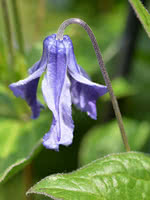Mon-Fri 9am - 5pm Mountain time
Blue Boy Clematis vs Black-Eyed Susan
Clematis integrifolia Blue Boy
Rudbeckia hirta
NOT AVAILABLE THIS SEASON - MIGHT RETURN
NOT AVAILABLE THIS SEASON - MIGHT RETURN
Blue Boy Clematis is a cold-hardy, fast growing, woody climbing vine. Hundreds of stunning steel-blue bell shaped flowers adorn the vine throughout the summer that droop and appear to hang in the air. The fibrous stems spread and create a fan-like symmetry shape.
This species will do best with support from a trellis, fence, or even other shrubs or tree stumps.
The Blue Boy Clematis was developed in Manitoba, Canada in 1947 by famous breeder Frank L. Skinner by crossing C. integrifolia x C. viticella, but it didn’t gain popularity until the 1990’s.
Black-Eyed Susan is a striking native wildflower known for its bright yellow, daisy-like flowers with dark center disks. With deadheading, the plant can bloom for an extended period, from mid-summer to early fall. These cheerful flowers attract a variety of pollinators, including bees and butterflies. Adding to its ecological value, the plant also acts as a host for the Wavy-Lined Emerald Moth (Synchlora aerata) and the Silvery Checkerspot (Chlosyne nycteis) butterfly.
While it is typically a short-lived perennial or biennial, the plant freely self-seeds. This allows it to persist in the landscape, particularly in natural areas where it can spread and establish itself. This plant is drought-tolerant, salt-tolerant, and deer and rabbit-resistant, making it ideal for challenging environments. The Black-Eyed Susan is well suited to wildflower gardens, pollinator gardens, as well as slopes, banks, and naturalized areas.

